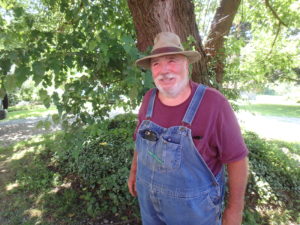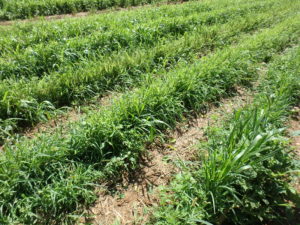Weeds? Why Worry?: One Farmer’s Perspective
I recently went to Cochranville, Pennsylvania to visit relatives, and they brought me to visit a successful farm-to-table farmer. I learned some new and interesting ways of looking at gardening, and I think they are worth sharing with you.
For the past 40 years or so Glenn Brendle has expanded his operation until now it encompasses about 40 acres of veggies. He grows everything from herbs, tomatoes and squash to dent corn, celery root (celeriac) and parsnips. He pays his 9 employees a living wage and does well for himself.
This spring the weather has been challenging for farmers in his part of Pennsylvania. The rain has been above average, sometimes falling 8 inches in a week. That is good for weeds, but not so good for farmers who want to have “clean” fields that look good from the road. “”Generally you don’t have to keep your fields as clean as people think. A lot is cosmetic,” Glenn told me.
Wet soils mean that he cannot use a tractor to control weeds, and some days even farm workers cannot trudge through the mud to hand-pull them. Fortunately, Glenn is not hung up about looks – he is more interested in growing high quality vegetables that he can sell to high-end restaurants.
Since Glenn grows organic vegetables, he cannot use pesticides to control weeds, or use genetically modified seeds. He depends on using a tractor or tiller to cultivate the space between rows to chew up the weeds, or hand pulling them.
He explained to me that if a row of carrots, for example, is clear of weeds on two sides, it is not too important if there are weeds in the bed with the carrots. This goes against everything most of us have been taught. But he pulled a few carrots to show me that they can compete with the weeds, and assured me that at harvest time they would be long and handsome.
In some fields we visited the weeds were taller than the vegetables. Glenn explained that the important thing is to prevent weeds from making seeds and dropping them in the soil. As soon as the fields dry out enough he will run a tractor with an attachment to mow over them with the blades set at a height that will top the weeds, but miss the vegetables. He suggested that home gardeners could accomplish that with a string trimmer.
Part of the reason his carrots and other crops can compete with weeds is that Glenn has worked hard at improving his soil every year. Among other things, he is a firm believer in the use of biochar.
Biochar is soil amendment from the partial burning of organic waste matter including branches or wood chips, leaf litter and dead plants. It is burned in a reduced-oxygen environment in a controlled process called pyrolosis, and results in a substance that resembles charcoal. It is available on-line, and from some garden centers.
Biochar is very stable – it can sequester carbon and store it for hundreds of years, or even longer. It is very porous with the innumerable small spaces available to hold bits of compost and microorganisms. Glenn mixes biochar that he makes himself with biologically active compost in water, allowing microbes to settle into the pores of the biochar. He spreads the mixture on the soil before planting. He believes that when a disease-causing microbe comes along, there is usually has a microbe that will inhibit its growth. And a healthy plant can compete with weeds better than a struggling plant.
What else did I learn? I have always insisted on keeping tomato plants off the ground, and most commercial farmers do so, even though that is a very labor-intensive and expensive to do. I use cages (54-inch, 4-legged heavy wire supports) for my tomatoes, or I tie them to wood stakes. But Glenn does not support his tomatoes. He lets them sprawl on the ground, sometimes smothering the weeds beneath them. Huh. He says his tomatoes do just fine.
Glenn grows lots of potatoes and says the best one he grows is a Dutch variety called ‘Bintje’. It is an early- to mid-season potato with yellow skin and flesh. It is resistant to some potato diseases, notably potato virus A and leaf-roll virus. It is susceptible to scab, however. Apparently it is the most commonly grown potato in France and Belgium, and was introduced for sale in 1910. He says it is the absolute best potato for making fries.
Woodchucks can do a lot of damage but Glenn has figured out how to trap them. He places a large Hav-a-Hart near a woodchuck’s hole and uses 2 wide boards about 5 feet long and 10 inches wide to create a V-shaped chute leading to the open mouth of the trap. He doesn’t bother with bait. He said that they don’t see well, but will approach the trap and enter it as a way to proceed to the field. Clunk. The cage closes.
The old saying goes, “There is more than one way to skin a cat.” So I will try a little of Glenn’s methodology. I will remove the cages from 3 of my tomatoes and stop weeding around them and see how they do. I’ll experiment with biochar, but I hope I won’t have to try his woodchuck trick. I’ll report back at the end of the season, so stay tuned.
Henry is the author of 4 gardening books. He lives in Cornish Flat, NH.





